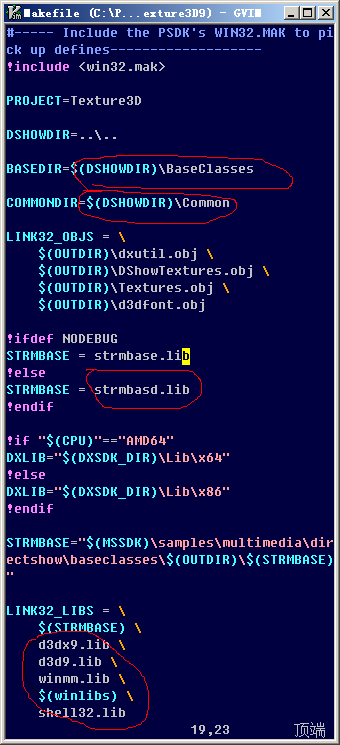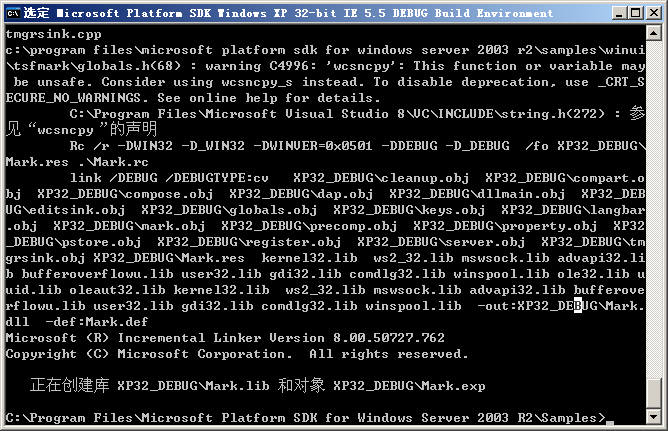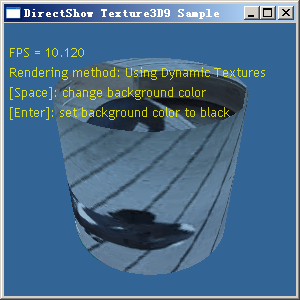位置Microsoft Platform SDK for Windows Server 2003 R2\Samples\Multimedia\DirectShow\Players\Texture3D9\
看名字就知道是把dshow解码出来的数据渲染到纹理上,但是这目录里面没有.proj项目文件,只有Makefile,为了方便,我们根据Makefile自己创建项目文件

附加包含目录: ..\..\BaseClasses;..\..\Common
链接
附加库目录: ..\..\BaseClasses\XP32_DEBUG
附加依赖项: d3dx9.lib d3d9.lib winmm.lib strmbasd.lib shell32.lib
这个strmbasd.lib不是安装了platform sdk就有了,要我们自己生成,如何生成呢?

选这个(Debug)的,进Samples目录,然后nmake,要比较长时间,出去遛个弯回来就好了

看到这样的画面应该就是生成好了。
特殊项目配置: 使用多字节字符集 用unicode的话有函数链接的时候找不到【重剑注:因为链接的strmbasd.lib不是unicode的,看这个
玩玩DirectShow--(4)Platform SDK生成Unicode版本的strmbasd.lib 】
多线程调试(/MTd) 不用这个就一堆link2005的错误
截图: 核心源码:
核心源码:
hr = g_pd3dDevice->CreateTexture(uintWidth, uintHeight, 1, D3DUSAGE_DYNAMIC,
D3DFMT_X8R8G8B8,D3DPOOL_DEFAULT,
&g_pTexture, NULL);
Using Dynamic Textures
更新texture数据的部分
HRESULT CTextureRenderer::DoRenderSample( IMediaSample * pSample )
{
BYTE *pBmpBuffer, *pTxtBuffer; // Bitmap buffer, texture buffer
LONG lTxtPitch; // Pitch of bitmap, texture
BYTE * pbS = NULL;
DWORD * pdwS = NULL;
DWORD * pdwD = NULL;
UINT row, col, dwordWidth;
CheckPointer(pSample,E_POINTER);
CheckPointer(g_pTexture,E_UNEXPECTED);
// Get the video bitmap buffer
pSample->GetPointer( &pBmpBuffer );
// Lock the Texture
D3DLOCKED_RECT d3dlr;
if( m_bUseDynamicTextures )
{
if( FAILED(g_pTexture->LockRect(0, &d3dlr, 0, D3DLOCK_DISCARD)))
return E_FAIL;
}
else
{
if (FAILED(g_pTexture->LockRect(0, &d3dlr, 0, 0)))
return E_FAIL;
}
// Get the texture buffer & pitch
pTxtBuffer = static_cast<byte *>(d3dlr.pBits);
lTxtPitch = d3dlr.Pitch;
// Copy the bits
if (g_TextureFormat == D3DFMT_X8R8G8B8)
{
// Instead of copying data bytewise, we use DWORD alignment here.
// We also unroll loop by copying 4 pixels at once.
//
// original BYTE array is [b0][g0][r0][b1][g1][r1][b2][g2][r2][b3][g3][r3]
//
// aligned DWORD array is [b1 r0 g0 b0][g2 b2 r1 g1][r3 g3 b3 r2]
//
// We want to transform it to [ff r0 g0 b0][ff r1 g1 b1][ff r2 g2 b2][ff r3 b3 g3]
// below, bitwise operations do exactly this.
dwordWidth = m_lVidWidth / 4; // aligned width of the row, in DWORDS
// (pixel by 3 bytes over sizeof(DWORD))
for( row = 0; row< (UINT)m_lVidHeight; row++)
{
pdwS = ( DWORD*)pBmpBuffer;
pdwD = ( DWORD*)pTxtBuffer;
for( col = 0; col < dwordWidth; col ++ )
{
pdwD[0] = pdwS[0] | 0xFF000000;
pdwD[1] = ((pdwS[1]<<8) | 0xFF000000) | (pdwS[0]>>24);
pdwD[2] = ((pdwS[2]<<16) | 0xFF000000) | (pdwS[1]>>16);
pdwD[3] = 0xFF000000 | (pdwS[2]>>8);
pdwD +=4;
pdwS +=3;
}
// we might have remaining (misaligned) bytes here
pbS = (BYTE*) pdwS;
for( col = 0; col < (UINT)m_lVidWidth % 4; col++)
{
*pdwD = 0xFF000000 |
(pbS[2] << 16) |
(pbS[1] << 8) |
(pbS[0]);
pdwD++;
pbS += 3;
}
pBmpBuffer += m_lVidPitch;
pTxtBuffer += lTxtPitch;
}// for rows
}
if (g_TextureFormat == D3DFMT_A1R5G5B5)
{
for(int y = 0; y < m_lVidHeight; y++ )
{
BYTE *pBmpBufferOld = pBmpBuffer;
BYTE *pTxtBufferOld = pTxtBuffer;
for (int x = 0; x < m_lVidWidth; x++)
{
*(WORD *)pTxtBuffer = (WORD)
(0x8000 +
((pBmpBuffer[2] & 0xF8) << 7) +
((pBmpBuffer[1] & 0xF8) << 2) +
(pBmpBuffer[0] >> 3));
pTxtBuffer += 2;
pBmpBuffer += 3;
}
pBmpBuffer = pBmpBufferOld + m_lVidPitch;
pTxtBuffer = pTxtBufferOld + lTxtPitch;
}
}
// Unlock the Texture
if (FAILED(g_pTexture->UnlockRect(0)))
return E_FAIL;
return S_OK;
}
2009-1-9 这个例子用到了platform sdk中的BaseClasses,用到引擎中的时候麻烦多多,我搞了几天,愣是编译不过!我日!考虑放弃dshow,用xvid
在游戏中播放过场电影
posted on 2008-12-23 00:23
七星重剑 阅读(1897)
评论(0) 编辑 收藏 引用 所属分类:
Game Graphics 、
IDE -- visual c++